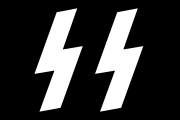Kamianets-Podilskyi massacre
| Kamianets-Podilskyi massacre | |
|---|---|
|
Jews marched through Kamenets to their execution site on the outskirts of town | |
| Date | August 27–28, 1941 |
| Target | Hungarian and Soviet Jews |
| Deaths | Total of 23,600 men, women and children |
The Kamianets-Podilskyi massacre was a World War II mass shooting of Jews carried out in the opening stages of Operation Barbarossa, by mobile killing squads of Nazi German Order Police Battalion 320 along with Jeckeln's Einsatzgruppen,[1] the Hungarian soldiers, and the Ukrainian Auxiliary Police. The killings were conducted on August 27 and August 28, 1941, in the Soviet city of Kamianets-Podilskyi (now Ukraine), occupied by German troops in the previous month on July 11, 1941.[2] According to Nazi German reports a total of 23,600 Jews were murdered, including 16,000 expellees from Hungary.[3]
History
The city of Kamianets-Podilskyi (Kam'yanets'-Podil's'kyy), now in south-western Ukraine, was part of the Ukrainian SSR invaded by German forces during the opening stages of Operation Barbarossa launched on June 22, 1941. Shortly after Hungary (Germany's ally) declared war on the Soviet Union on June 27, 1941, officials of the agency responsible for foreign nationals living in Hungary decided to deport foreign Jews; these were mostly Polish and Russian Jews, but there were also many refugees from western Europe. Jews who could not readily establish Hungarian citizenship were equally vulnerable to deportation. As a result, many Hungarian Jews who could not document their citizenship were also deported. Many Jewish communities, especially in the Transcarpathian Ukraine (then under Hungarian control), were deported in their entirety.
The Hungarians loaded the Jews into freight cars and took them to Kőrösmező (now Yasinia, Ukraine), near the prewar Hungarian-Polish border, where they were transferred across the former Soviet border and handed over to the Germans. By August 10, 1941, approximately 14,000 Jews had been deported from Hungary to German-controlled territory. Once in German hands, the Jews, often still in family units, were forced to march from Kolomyia to Kamianets-Podilskyi.
On August 27 and 28, detachments of Einsatzgruppen (mobile killing units) in Kamianets-Podilskyi and troops under the command of the Higher SS and Police Leader for the southern region, SS General Friedrich Jeckeln, carried out mass killings of the Jewish deportees as well as the local Jewish population. According to Jeckeln's report, a total of 23,600 Jews were massacred in this action, the first large-scale mass murder in pursuit of the Final Solution.[4]
See also
- Einsatzgruppen
- Friedrich Jeckeln
 Media related to The Holocaust in Ukraine at Wikimedia Commons
Media related to The Holocaust in Ukraine at Wikimedia Commons
References
- ↑ Timothy Snyder (2010). Bloodlands: Europe Between Hitler and Stalin. Basic Books. pp. 200–204. ISBN 0465002390.
- ↑ Martin Davis. "Kamyanets-Podilskyy" (PDF). pp. 11-14 / 24 in PDF – via direct download. Also in: Martin Davis (2010). "The Nazi Invasion of Kamenets". JewishGen.
- ↑ Randolph L. Braham (2000). The Politics of Genocide. Wayne State University Press. p. 34. ISBN 0814326919.
- ↑
- Mallmann, Klaus-Michael (2001). Der qualitative Sprung im Vernichtungsprozeß: das Massaker von Kamenez-Podolsk Ende August 1941 [The jump in quality of the extermination process: the Kamianets-Podilskyi massacre, end of August 1941]. Jahrbuch für Antisemitismusforschung (in German). 10. pp. 239–264. ISBN 3-593-36722-X.
- United States Holocaust Memorial Museum - Kamenets-Podolsk
- This article incorporates text from the United States Holocaust Memorial Museum, and has been released under the GFDL.
- Yad Vashem Digital Collections. Source: Rabbi Baruch Jehoszua Rachmiel Rabinowicz. Kamenets Podolskiy mass grave, photos from Hungarian officers who took them. Item ID: 26094.
Coordinates: 48°41′00″N 26°35′00″E / 48.68333°N 26.58333°E

